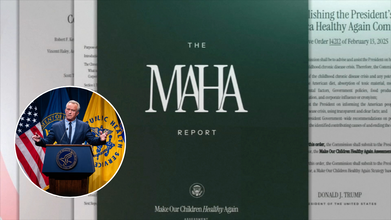- Health Conditions A-Z
- Health & Wellness
- Nutrition
- Fitness
- Health News
- Ayurveda
- Videos
- Medicine A-Z
- Parenting
- Web Stories
A 4-Step Science-Backed Routine That Works for Every Skin Type

There was a time when skincare felt like a competitive sport. People layered acids, scrubbed their faces raw, and measured success in stings, peels, and redness. But times are changing. A new, science-backed wave is sweeping in, one that values results without leaving your skin feeling like it has been through a survival reality show.
From Shelf Overload to Skincare Simplicity
For years, we’ve been told more is better. More products, more steps, more actives, until our bathroom shelves looked like mini-pharmacies. But skin, much like us, thrives in balance. Aggressive routines may deliver quick wins, but they often come with side effects like irritation, dryness, or breakouts that weren’t invited to the party.The modern approach is a gentler, more measured one: using well-formulated products that are kind to the skin barrier but still pack enough punch to make a visible difference. And the best part? You only need a few steps, not a 12-item shopping list.
The Four Steps That Actually Work
Malini Adapureddy, Founder of Deconstruct Skincare, swears by a routine that’s simple enough to remember before coffee and effective enough to see results in weeks. Designed for Indian skin and climate, this four-step method covers the essentials: cleansing, treating, moisturising, and protecting.
Step 1: The Clean Slate
Every story starts somewhere, and for your skin, that’s cleansing. But the goal isn’t to strip your face like it’s a frying pan that’s just seen a masala spill. A gentle oil-control face wash with salicylic acid and niacinamide is the ticket. Salicylic acid slips into pores to keep them clear, while niacinamide calms and balances.Step 2: The Targeted Glow Shot
Once the canvas is prepped, it’s time for the serum stage. Enter a 10% vitamin C serum with 0.5% ferulic acid. Vitamin C is your radiance best friend, helping to fade pigmentation and even out skin tone, while ferulic acid boosts its stability and antioxidant power. Together, they help defend against environmental stressors and bring your complexion back from the land of dull.Unlike some actives that feel like they’re burning through your soul, this combination is gentle enough for daily use.
Step 3: The Barrier Hug
Moisturiser is often seen as the “optional” step, especially if you have oily skin. But hydration isn’t just about adding water; it’s about locking it in. A lightweight, oil-free moisturiser with natural moisturising factors (NMF) and panthenol keeps your skin barrier happy. It helps reduce sensitivity, supports repair, and works in harmony with your actives. And in India’s hot, humid, sometimes dusty climate, that’s a much-needed shield.Step 4: The Non-Negotiable
Sunscreen. Always sunscreen. Whether you’re outside chasing errands or inside chasing deadlines, UV damage is sneaky. It causes pigmentation, speeds up ageing, and undoes all the hard work your serum and moisturiser put in. A broad-spectrum, gel-based sunscreen keeps things light, non-greasy, and comfortable, even under makeup.Why Gentle Works Better Than You Think
There’s a myth that 'strong' means 'effective'. In reality, harsh products can damage your skin barrier, leaving it inflamed and reactive. Gentle formulations, when done right, work gradually but deeply. They’re like the friend who doesn’t shout advice but still changes your life.Consistency is the secret here. When your skin isn’t constantly fighting irritation, it can focus on repairing itself, building resilience, and looking better over time.
High Blood Pressure And Cognitive Decline Strongly Linked - New American Heart Association Guidelines States

The American Heart Association (AHA) has updated its official recommendations for dealing with high blood pressure, replacing the old rules from 2017. These new guidelines are the result of a deep look into the latest research, providing doctors and patients with better information on how to understand, prevent, and treat high blood pressure. They are designed to be a clearer, more effective guide for everyone.
High blood pressure is one of the biggest silent killers globally. Although many people suffer from it, most do not make the necessary changes to ensure that their health doesn’t deteriorate. A global estimate of about 1.28 billion adults aged 30-79 years has hypertension, according to the World Health Organizations (WHO). It is also estimated that 46% of these people are unaware that they have the condition.
To ensure that people keep their health in check, government and health institutions issue health guidelines that help people take care of their health.
What Are The Latest Changes To High Blood Pressure Guidelines?
The new guidelines highlight several key points:
Brain Health
There is now stronger evidence linking high blood pressure to an increased risk of cognitive decline and dementia. Managing your blood pressure now may help protect your brain in the future.
Leading Risk Factor
High blood pressure remains the top risk factor for serious health problems like stroke, coronary artery disease, heart failure, and AFib.
Pregnancy-Related Hypertension
The new guidelines feature specific blood pressure categories for pregnant individuals to help detect serious risks, such as preeclampsia. Regular blood pressure checks are now considered crucial. It's important for expectant mothers to monitor their blood pressure closely before, during, and after pregnancy to ensure their health and the safety of their baby.
- Normal blood pressure is when your top number is less than 140 and your bottom number is less than 90.
- Hypertension in pregnancy is when your top number is 140 or higher, or your bottom number is 90 or higher.
- Severe hypertension is when your top number is 160 or higher, or your bottom number is 110 or higher.
Tips for Managing Your Blood Pressure
You can take steps to manage or prevent high blood pressure through a combination of lifestyle changes and, if needed, medication. For the most accurate reading, sit with your back supported, feet flat on the floor, and arm extended at heart level.
Dietary Changes
- Aim for less than 2,300 mg of sodium per day (about one teaspoon of salt). The ideal goal is less than 1,500 mg.
- Follow a heart-healthy diet like the DASH eating plan, which focuses on fruits, vegetables, whole grains, nuts, and low-fat dairy.
- Drinking less or no alcohol can help lower your blood pressure.
- Losing even a small amount of weight (at least 5% of your body weight) can help lower blood pressure. For example, if you weigh 180 pounds, losing just 9 pounds can make a difference.
- Activities like meditation, controlled breathing, or yoga can help.
- Ask your healthcare professional about other conditions that can cause high blood pressure, such as sleep apnea, diabetes, and thyroid problems.
What Does General Blood Pressure Look Like?
It's important for everyone to understand their blood pressure numbers. The new guidelines classify blood pressure into these categories:
Normal: Your top number is less than 120 and your bottom number is less than 80.
Elevated: Your top number is between 120 and 129, and your bottom number is less than 80.
Stage 1 Hypertension: Your top number is between 130 and 139, or your bottom number is between 80 and 89.
Stage 2 Hypertension: Your top number is 140 or higher, or your bottom number is 90 or higher.
A hypertensive crisis is a medical emergency that occurs when your blood pressure is higher than 180/120. If your blood pressure reaches this level and you have symptoms like chest pain, shortness of breath, or numbness, you should call emergency services. If you need a health and diet guide, you can follow the ‘Life’s Essential 8’, the guideline that helps keep our health a priority by the American Heart Association.
Too Many Pills, Too Little Produce: Draft 'Make America Healthy Again' Report Blames Junk Food, Pills And Inactivity

Credits: Health and me
The US Department of Health and Human Services (HHS), under Secretary Robert F. Kennedy Jr., has been touting its “Make America Healthy Again” (MAHA) initiative as a turning point in public health. Framed as one of Kennedy’s signature achievements, the report promised bold action to address America’s chronic health crises: obesity, diabetes, heart disease, and the overprescription of pharmaceuticals.
A draft version obtained by reporters tells a different story. Instead of sweeping reforms to food, farming, or pharmaceutical regulation, the MAHA report leans heavily on additional research studies, awareness campaigns, and incremental policy suggestions. For a coalition that expected Kennedy to challenge entrenched interests—from pesticide manufacturers to Big Food—the document feels less like a revolution and more like a compromise.
What Are The Four Problem Areas?
The draft report identifies four main drivers of chronic disease in the United States:
- Poor diets dominated by ultraprocessed foods, sugars, and additives.
- Chemical exposure from pesticides and environmental pollutants.
- Lack of physical activity, worsened by sedentary jobs and urban lifestyles.
- Overuse of prescription medications, particularly among children and older adults.
These themes mirror Kennedy’s longstanding critiques of America’s health system. Yet, the policies outlined in the draft stop short of mandating aggressive reform. Instead, they recommend more studies, more definitions, and more “public awareness” campaigns.
Where the Bold Promises Fall Short In MAHA Report?
Kennedy built his reputation criticizing chemicals like glyphosate, high-fructose corn syrup, and ultraprocessed snacks that dominate the American diet. Farmers and food manufacturers braced for the MAHA report to recommend bans or new regulations. Instead, the draft calls for a public “confidence-building” campaign to reassure Americans about pesticides.
This pivot has disappointed many in Kennedy’s own coalition. Public health experts like Marion Nestle, professor emerita of nutrition at NYU, argue the draft contradicts the urgency of America’s chronic disease crisis. “The first report promised bold policies to protect children’s health. No such luck here,” she told reporters.
Industry Relief, Activist Frustration
For the agricultural sector, the draft report is a relief. It proposes partnerships with major farm companies and research into “precision technology” to help reduce pesticide use—steps that industry leaders see as constructive rather than combative.
But health advocates feel sidelined. Kari Hamerschlag, deputy director of food and agriculture at Friends of the Earth, warned that without funding, the report’s recommendations won’t translate into healthier outcomes. “This is not going to transform our food and farming system. They need to put resources behind their recommendations,” she said.
Processed Foods and the Unfinished Fight
Perhaps the biggest surprise in the draft is its limited attention to ultraprocessed foods. The MAHA movement originally spotlighted processed snacks and additives as central culprits in the nation’s obesity epidemic. But the draft only mentions that government agencies will “define” ultraprocessed foods and continue education campaigns.
Former FDA Commissioner Dr. David Kessler has argued that ingredients like refined sugars and flours should be declared unsafe. Yet the draft sidesteps any such regulatory proposals, leaving critics frustrated. Dr. Jim Krieger of Healthy Food America noted: “What about removing them from schools? Restricting marketing? Labeling packages? None of that is here.”
Research Without Teeth
The draft MAHA document devotes significant space to research priorities. It calls for the National Institutes of Health (already facing severe budget cuts under the Trump administration) to study vaccine injury, autism, infertility, prescription drug use, and nutrition. It also proposes AI-driven tools to accelerate research on pediatric cancers.
While these initiatives sound ambitious, they are contingent on funding that may never materialize. Without resources, they risk becoming yet another set of unfulfilled promises.
The Political Undercurrent
The White House has been cautious about the report’s release. A spokesperson called the draft “speculative literature” until officially endorsed. But insiders suggest the policies align closely with what was already previewed to the administration.
That alignment may explain the softened language around pesticides and ultraprocessed foods. For an administration prioritizing farmer support and deregulation, MAHA’s original vision of challenging chemical companies and processed food giants was politically untenable.
Is The New MAHA Report Building Bridges or Losing Focus?
Calley Means, one of Kennedy’s advisers, urged supporters to “build bridges” with farmers and agribusiness rather than treat them as enemies. It’s a pragmatic strategy, but critics argue it dilutes the urgency of tackling the systemic causes of poor health.
David Murphy, a former Kennedy finance director and now founder of United We Eat, framed the debate succinctly: “No one’s trying to take away farmers’ rights to grow food. We’re asking companies whose products cause harm to be held liable.” That principle, however, is largely absent from the draft.
What This Means for The People of America?
For everyday Americans grappling with obesity, diabetes, or high medical bills, the draft report offers little immediate relief. It encourages healthier diets, more exercise, and reduced reliance on medications—but without meaningful changes to food policy, medical regulation, or funding streams, these remain aspirational goals.
In essence, the report acknowledges the crises but avoids decisive confrontation with the industries fueling them. The result is a strategy that risks being too cautious to make a measurable impact.
The MAHA Commission’s final report is expected soon, but public health advocates are already voicing skepticism. Hundreds have signed letters urging the administration to address chemical exposures and ultraprocessed foods more directly. Whether those appeals shape the final draft remains to be seen.
What’s clear is that America’s chronic health problems—rising obesity, diabetes, cancer, and mental health conditions—demand more than “awareness campaigns.” Without stronger action, the “Make America Healthy Again” slogan risks becoming another empty political catchphrase.
What Is Pulmonary Fibrosis and Why That Annoying Cough Might Be More Than Just a Cold

Credits: Canva
If you’ve been coughing for weeks, blaming it on “lingering winter sniffles” or chalking it up to “just getting older,” it might be time to step away from the cough syrup and lean in for some uncomfortable truth. Your cough could be more than a seasonal annoyance. In rare but serious cases, it could be a red flag for a life-limiting condition called pulmonary fibrosis.
What is Pulmonary Fibrosis?
In plain terms, “pulmonary” means lungs, and “fibrosis” means scarring. It’s a serious, progressive condition where lung tissue becomes scarred and stiff, making it increasingly hard to breathe.
Reportedly, there’s currently no cure. Treatments exist, but they mainly slow down the damage rather than reverse it. The sooner you get diagnosed, the better your chances of managing symptoms and that’s where spotting the signs early is crucial.
Symptoms to Watch For
- Shortness of breath (especially when climbing stairs or speed-walking to catch the bus)
Why That Cough Happens
Coughing is your body’s bouncer, booting out anything that might harm your lungs — dust, smoke, rogue crumbs, the works. The process involves your vocal cords clamping shut, then snapping open with a burst of air.
With pulmonary fibrosis, this reflex can get stuck on a loop. Coughing irritates the vocal cords, which makes you cough more, which irritates them further, a vicious cycle that can turn even a quiet cup of tea into a coughing fit.
The Four Flavours of Cough
- Acute cough – Lasts less than three weeks; often tied to infections or irritants.
Coughs can also be:
- Dry/unproductive – Triggered by things like temperature changes, dusty air, or laughing.
Who’s More at Risk?
While pulmonary fibrosis can happen to anyone, your risk might be higher if you:
- Are over 50
Managing the Cough
A pulmonary fibrosis cough often doesn’t respond to standard cough medicines. Instead, treatment usually focuses on easing symptoms and improving quality of life.
Your doc may recommend alternative medications used for chronic cough in other conditions. These don’t cure the scarring but can make the coughing less intrusive. They’ll also want to check for other contributing factors like acid reflux, sinus issues, or side effects from medication, because if those are making things worse, tackling them can help.
Everyday Coping Tricks
While you work with your doctor, you can try a few lifestyle tweaks to manage coughing fits:
- Avoid smoky, dusty, or heavily polluted spaces
Pulmonary fibrosis is rare, but catching it early can mean more treatment options and better management. Plus, you’ll finally know whether your cough is from a stubborn cold or something that needs closer attention. Your cough could be a harmless side effect of a dusty ceiling fan or it could be your body waving a red flag.
© 2024 Bennett, Coleman & Company Limited

